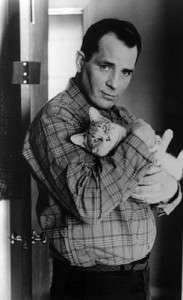Jack Kerouac owes a good chunk of his literary fame to a spectacular diving touchdown he made for the Lowell High School Red and Grays on a cold Thanksgiving Day in 1938.
Jean-Louis Kerouac was born in Lowell, Mass., on March 12, 1922, the son of Franco-American immigrants. Lowell was no longer the splendid city of industry populated by well-paid mill girls who attended highbrow lectures in their spare time. It was a city left struggling by the demise of the textile industry, populated by immigrants from Greece, Poland, Ireland and Canada.
Kerouac’s father was a printer who lost his shop in a flood; his mother worked in a shoe factory. French was his first language. Jack didn’t learn to speak English until he was six, and he started writing his masterpiece, On The Road, in French. He grew up a serious student and a devout Catholic. As a child he was told his family motto was ‘Love, Work, Suffer.’
Before his early death on Oct. 21, 1969, he published more than a dozen books that earned him a devoted underground following. Critics called him ‘the voice of his generation,’ and On The Road became the bible of the Beat Generation
But it was his early triumph on the football field that gave him his biggest thrill. Kerouac once said:
There is nothing like being a football star, not even publishing your first novel.
Scholarship
Kerouac wanted to be a writer, an unlikely career choice for someone who was poor, French-Canadian and lived in the Pawtucketville section of the city. A priest advised him to get a scholarship to college. Kerouac knew football was the way out.
He was small for football at 5’7” and 150 pounds, but he had powerful legs and could run fast. Kerouac went out for the varsity team, but sat on the bench until an assistant coach called him into a game. He impressed the coaches with his determination, but he used his head a lot. Some physicians speculate that may have contributed to his mental health issues later in life.
Jack Kerouac developed into a speedy halfback who in his senior year attracted college scouts. He had his heart set on going to Columbia College in New York City, and he played like a demon that season.
The climax of his season came on the final game, a Thanksgiving Day grudge match between Lowell and Lawrence high schools. A record 14,000 people came to Lawrence Memorial Stadium to watch the game.
With the game nearly over, Lowell led 2-0 and was on Lawrence’s 17-yard line. The Lowell quarterback tossed a screen pass to Kerouac, but it was tipped by a Lawrence defender. Kerouac managed to catch the ball anyway inches off the ground and sprint toward the goal line with Lawrence players at his heels. On the five-yard line he dropped his shoulder and barreled through two Lawrence defenders, then dived over the goal line to score the only touchdown of the game.
When he returned home to Pawtucketville after the game, neighbors called from upstairs windows or rushed into the streets to congratulate him.
The touchdown won him a scholarship to Columbia.
Taking A Chance
He didn’t have much of a football career in college. He cracked a tibia in his freshman year and quarreled with his coach during a short sophomore season. Kerouac then dropped out of college.
He continued to live in the Columbia neighborhood on New York’s Upper West Side. There he met and befriended the writers who would define the Beat Generation: Allen Ginsberg, Neal Cassady, Herbert Huncke and William S. Burroughs. Kerouac would become one of the Beats’ most acclaimed writers.
Long after the Beat Generation started collecting Social Security, Kerouac continues to inspire a devoted following. His biographer Barry Gifford observed in Jack’s Book:
His novels inspired thousands and thousands of readers … to get the hell out of whatever boring or dead-end situation they were in and take a chance with their lives.
With thanks to Subterranean Kerouac: The Hidden Life of Jack Kerouac by Ellis Amburn. This story updated in 2022.



7 comments
[…] earliest and most important advocates of working women’s rights. Like another Lowell native – Jack Kerouac, a century later – she refused to be stuck in a second-class […]
[…] team had to compete with high school and college teams for fans and with elementary school students for practice time. Its star player […]
[…] the small Gothic Revival building with $2,000 from her mother. The young couple was influenced by Jack Kerouac and the Beats. Alice was an artist, Ray was a woodworker and architect. They both worked at the […]
[…] 18, Jane Toppan graduated from Lowell High School. The Toppans freed Jane from her indenture and gave her $50, but she stayed in the household as a […]
[…] most famous Franco-American author, Jean-Louis Lebris de Kérouac or Jack Kerouac, was born in Lowell’s Little […]
[…] Ginsberg, who frequently visited Lowell, hung out with Kerouac’s relatives and drinking buddies. He tried to educate the Rolling Thunder Revue about Jack Kerouac. […]
[…] in Lowell, Mass., loved to watch sports and to play them. A high school football star, he made a diving touchdown that saved the game for the Lowell Red and Grays in 1938. That won him a football scholarship to Columbia College in New York, where he made […]
Comments are closed.